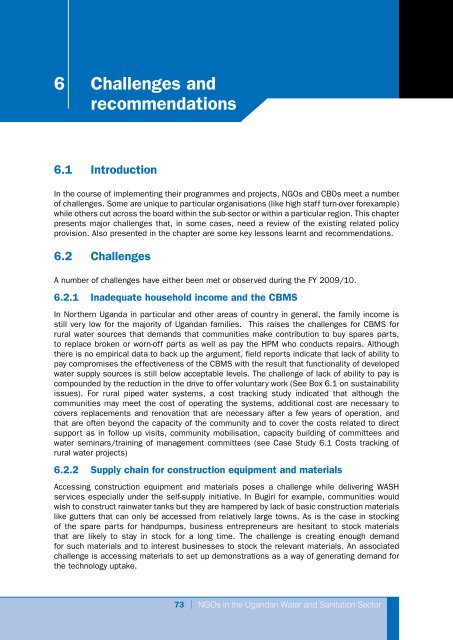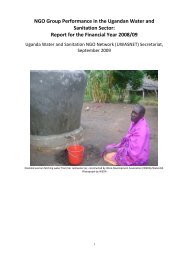Performance Report for FY 2009/10 - UWASNET
Performance Report for FY 2009/10 - UWASNET
Performance Report for FY 2009/10 - UWASNET
Create successful ePaper yourself
Turn your PDF publications into a flip-book with our unique Google optimized e-Paper software.
6 Challenges and<br />
recommendations<br />
6.1 Introduction<br />
<strong>Per<strong>for</strong>mance</strong> <strong>Report</strong> <strong>for</strong> <strong>FY</strong> <strong>2009</strong>/<strong>10</strong><br />
In the course of implementing their programmes and projects, NGOs and CBOs meet a number<br />
of challenges. Some are unique to particular organisations (like high staff turn-over <strong>for</strong>example)<br />
while others cut across the board within the sub-sector or within a particular region. This chapter<br />
presents major challenges that, in some cases, need a review of the existing related policy<br />
provision. Also presented in the chapter are some key lessons learnt and recommendations.<br />
6.2 Challenges<br />
A number of challenges have either been met or observed during the <strong>FY</strong> <strong>2009</strong>/<strong>10</strong>.<br />
6.2.1 Inadequate household income and the CBMS<br />
In Northern Uganda in particular and other areas of country in general, the family income is<br />
still very low <strong>for</strong> the majority of Ugandan families. This raises the challenges <strong>for</strong> CBMS <strong>for</strong><br />
rural water sources that demands that communities make contribution to buy spares parts,<br />
to replace broken or worn-off parts as well as pay the HPM who conducts repairs. Although<br />
there is no empirical data to back up the argument, field reports indicate that lack of ability to<br />
pay compromises the effectiveness of the CBMS with the result that functionality of developed<br />
water supply sources is still below acceptable levels. The challenge of lack of ability to pay is<br />
compounded by the reduction in the drive to offer voluntary work (See Box 6.1 on sustainability<br />
issues). For rural piped water systems, a cost tracking study indicated that although the<br />
communities may meet the cost of operating the systems, additional cost are necessary to<br />
covers replacements and renovation that are necessary after a few years of operation, and<br />
that are often beyond the capacity of the community and to cover the costs related to direct<br />
support as in follow up visits, community mobilisation, capacity building of committees and<br />
water seminars/training of management committees (see Case Study 6.1 Costs tracking of<br />
rural water projects)<br />
6.2.2 Supply chain <strong>for</strong> construction equipment and materials<br />
Accessing construction equipment and materials poses a challenge while delivering WASH<br />
services especially under the self-supply initiative. In Bugiri <strong>for</strong> example, communities would<br />
wish to construct rainwater tanks but they are hampered by lack of basic construction materials<br />
like gutters that can only be accessed from relatively large towns. As is the case in stocking<br />
of the spare parts <strong>for</strong> handpumps, business entrepreneurs are hesitant to stock materials<br />
that are likely to stay in stock <strong>for</strong> a long time. The challenge is creating enough demand<br />
<strong>for</strong> such materials and to interest businesses to stock the relevant materials. An associated<br />
challenge is accessing materials to set up demonstrations as a way of generating demand <strong>for</strong><br />
the technology uptake.<br />
73 | NGOs in the Ugandan Water and Sanitation Sector



